- Details
- Hits: 3607
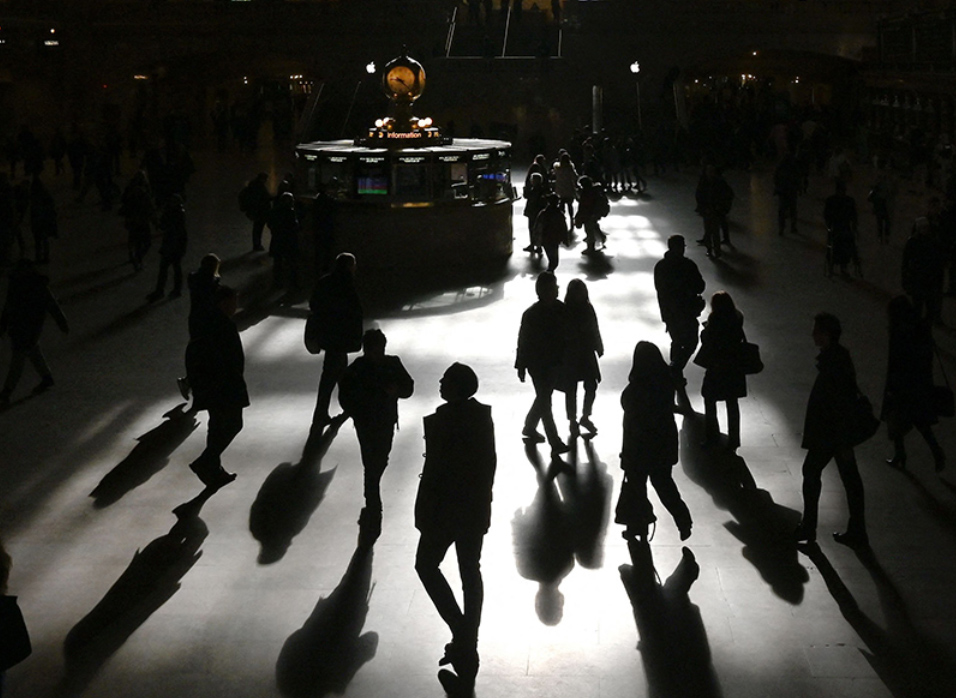 In a 24 March 2025 article from the on-line Science Advisor (American Association for the Advancement of Science) Phie Jacobs summarizes the "great debate" of the yearly shift from standard time to daylight savings time. In January 2025 the US Senate introduced the Sunshine Protection Act to permanently have daylight savings time year round. Certainly 54% of Americans do not like the annual migration from standard to savings time and back. In the US, daylight savings time was instituted in 1918 during World War I.
In a 24 March 2025 article from the on-line Science Advisor (American Association for the Advancement of Science) Phie Jacobs summarizes the "great debate" of the yearly shift from standard time to daylight savings time. In January 2025 the US Senate introduced the Sunshine Protection Act to permanently have daylight savings time year round. Certainly 54% of Americans do not like the annual migration from standard to savings time and back. In the US, daylight savings time was instituted in 1918 during World War I.
"José María Martín-Olalla, a physicist at the University of Seville and lead author of the new position paper, argues that seasonal clock changes also represent a practical solution to a broader problem: reconciling the fixed, clock-driven schedule of modern life with sunrise times that vary throughout the year."
Jacobs points out that numerous studies have linked time-related sleep disruptions to increases in heart attacks, strokes, traffic accidents, and workplace injuries, and sleep researchers strongly oppose that idea on the basis that extra-dark mornings and extra-bright evenings would dangerously disrupt people’s sleep. Many medical and scientific organizations instead advocate for permanent standard time.
Jacobs sees a middle point, saying that according to Fong-Isariyawongse, human biology functions according to light exposure and people’s circadian rhythms already naturally adjust throughout the year. “Instead of manipulating clocks,” she says, “a better approach would be to allow workplaces and schools more flexibility in adapting schedules based on natural light conditions.”
There is no easy solution. Maybe the middle ages had it right using unequal time.
Read the full article at: https://www.science.org/content/article/scientists-weigh-pros-and-cons-daylight-saving-time
Photo credit: Timothy A. Clary/AFP via Getty Images
- Details
- Hits: 8364
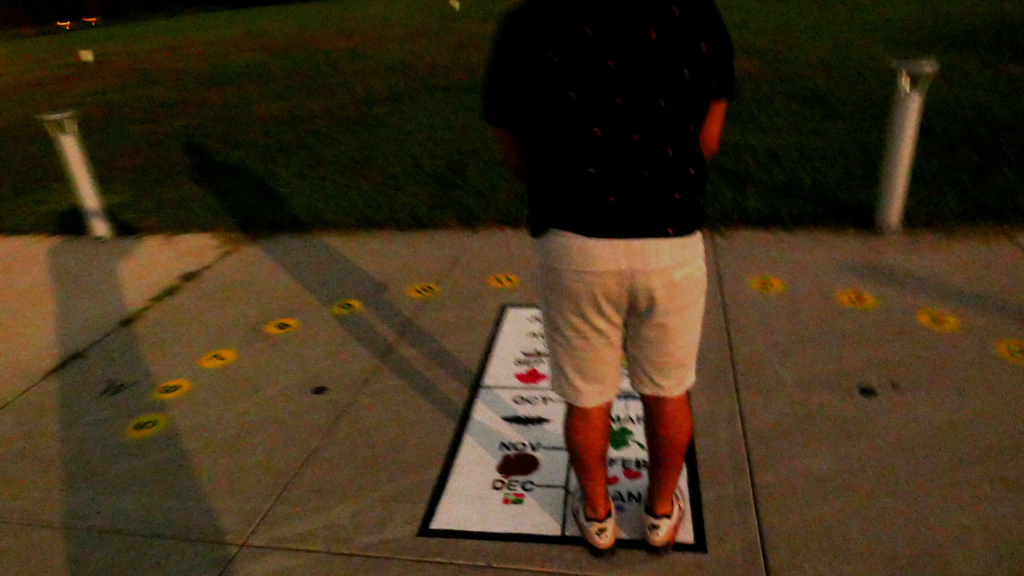 By the Light of the Moon
Photo by Dr. Jeff Kretsch
|
The analemmatic (human) sundial at Turner Farm Observatory Park in Great Falls, VA made by Eagle Scout candidate Kenny Dieffenderfer and Troop 1547 marked a unique place in sundialing history this July 23rd. The Analemma Society sponsors free Friday night public viewing of the heavens through telescopes at Turner Farm's Roll-Top Observatory. But just outside the Observatory on the sidewalk is Kenny's analemmatic dial. Could this dial tell correct time by the light of the moon?
On July 23rd this question was put to the test. It was almost exactly a full moon and the sky was clear. As can be seen in the accompanying photo taken by Dr. Jeff Kretsch at approximately 10:10pm EDT, the lunar shadow of a volunteer human gnomon cast a shadow of about 9:10pm standard moon civil time. How did this come about?
The important facts needed to make the analemmatic dial tell the correct "moon time" is knowing both the phase of the moon and the declination of the moon. On that night the moon was very close to being exactly a full moon and the declination of the moon was 25 degrees south of the equator. The maximum that the sun ever gets is 23.45 degrees south of the equator at the winter solstice. That means that (with practical precision) even though it was a late July night, the human gnomon must stand on the dial's zodiac walkway at the Dec-Jan winter solstice mark.
If this were the sun, we apply a plus 8 minute correction for the 77 deg west longitude of the observatory. The moon gets the same treatment. But what about the moon's phase and the "equation of time"? Here we find a fortunate coincidence: The moon was full moon at 10:37pm EDT on that Friday night, so by luck the moon was almost exactly opposite the sun. The moon's average full moon to full moon (a synodic month) is 29.53 days. Thus the average moon's lead or lag of a mythical full moon is about 49 minutes per day. Therefore the lunar phase correction is approximately 49 x 20/1440 = 0.68 minutes (41 seconds) ahead of the average full moon. Finally the sun's EOT for Friday July 23rd is approximately 6min 30 sec to be added to a dial's shadow to get civil time. But the moon opposite the sun has EOT in the opposite direction of minus 6min 30 sec. The net lunar correction is therefore +8.0 -.68 -6.5 = 50 sec, just less than one minute that needs to be added to that night's observation analemmatic shadow. One might say that the moon and sun were in perfect alignment!
- Details
- Hits: 11666
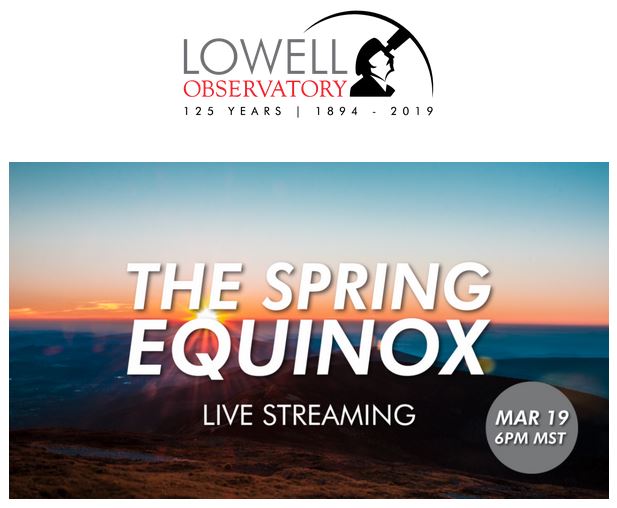 Here in Great Falls Virginia on the day of the Spring Equinox, March 19th, it's a rainy day. Perhaps that helps us want to stay inside with all of the travel and meetings restrictions imposed because of the Covid-19 virus. However, astronomical events aren't deferred because of human and biological issues. Late today the sun crosses the celestial equator and heralds in Spring. You can observe this event remotely thanks to Lowell Observatory in Arizona. Lowell Observatory will begin Live Streaming the event starting at 9pm EDT. "The spring equinox in 2020 occurs on Thursday, March 19 at 8:49pm MST/PDT (3:49am GMT), when the Earth's axis is exactly perpendicular to an imaginary line drawn between the Earth and Sun. On the equinox, the Sun rises due east, and it sets due west, no matter where you are on the Earth."
Here in Great Falls Virginia on the day of the Spring Equinox, March 19th, it's a rainy day. Perhaps that helps us want to stay inside with all of the travel and meetings restrictions imposed because of the Covid-19 virus. However, astronomical events aren't deferred because of human and biological issues. Late today the sun crosses the celestial equator and heralds in Spring. You can observe this event remotely thanks to Lowell Observatory in Arizona. Lowell Observatory will begin Live Streaming the event starting at 9pm EDT. "The spring equinox in 2020 occurs on Thursday, March 19 at 8:49pm MST/PDT (3:49am GMT), when the Earth's axis is exactly perpendicular to an imaginary line drawn between the Earth and Sun. On the equinox, the Sun rises due east, and it sets due west, no matter where you are on the Earth."
https://www.youtube.com/watch?v=LqP1Md85HHs&feature=youtu.be
- Details
- Hits: 14731
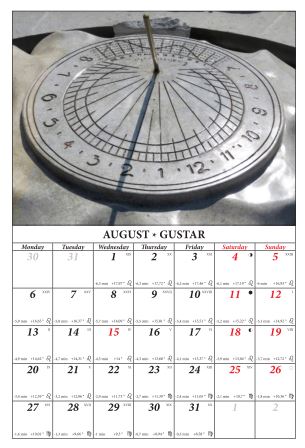 Dan-George Uza has prepared a calendar for 2018 "containing images of Romanian sundials and some daily astronomical information (the equation of time, the Sun's declination angle & zodiac sign, the Moon's phase & age etc.).... The calendar reflects the usual Romanian practice of starting weeks on Mondays, being the first working day, although orthodox religious calendars have reverted to starting weeks on Sundays due to religious reasons since 2011. The days of the week have been translated to their English counterparts for your convenience. Apart from the last two, which have different etymological background, they all closely follow the names of the ancient planets" Luni - Luna (Moon), Marti - Marţe (Mars), Miercuri - Mercury (Mercury), Joi - Joe/Jupiter (Jujpiter), Vineri - Venus (Venus) Sámbătă - from the Latin sa(m)bbatum meaning Sabbath, Duminica - from the Latin (dies) Dominica meaning day of the Lord. .... You may download the English version at the link below:"
Dan-George Uza has prepared a calendar for 2018 "containing images of Romanian sundials and some daily astronomical information (the equation of time, the Sun's declination angle & zodiac sign, the Moon's phase & age etc.).... The calendar reflects the usual Romanian practice of starting weeks on Mondays, being the first working day, although orthodox religious calendars have reverted to starting weeks on Sundays due to religious reasons since 2011. The days of the week have been translated to their English counterparts for your convenience. Apart from the last two, which have different etymological background, they all closely follow the names of the ancient planets" Luni - Luna (Moon), Marti - Marţe (Mars), Miercuri - Mercury (Mercury), Joi - Joe/Jupiter (Jujpiter), Vineri - Venus (Venus) Sámbătă - from the Latin sa(m)bbatum meaning Sabbath, Duminica - from the Latin (dies) Dominica meaning day of the Lord. .... You may download the English version at the link below:"
https://goo.gl/FNafub
Dan explains that the calendar " includes a brief introduction to the Romanian calendar, such as an explanation for the names of the days and months, the dates of national holidays etc. This is actually my second calendar. I did the first one last year inspired by Fabio Savian's French Republican Calendar. A big thanks goes to Patrick Powers who was kind enough to correct my spelling mistakes for this English edition."
"The astronomical data was generated in Sun Ephemeris, Gian Casalegno's excellent software. The calendar is freeware so you may of course share it. It's intended for A3++ size paper (330x483mm) but I guess simple A3 will do."
"Have a Happy New Year or - as we like to say in Romanian - La Multi Ani!"
- Details
- Hits: 13393
|
|
In Perryville, Missouri, Perry County unveilled a sundial commemprating the coming August 21st total solar eclipse. Mike Mohundro, Photojournalis for Hearland News (KFVS Channel 12) interviewed Trish Erzfeld, Perry Count Heritage Tourism Director, who said "We just wanted something after the eclipse is over with that the community can be proud of and reflect back on." Mohundro went on to write "many organizations worked on this project together including Earthworks, the [North] American Sundial Society, St. Louis Stone Artist Abraham Mohler, Perry County and more."
The sundial, shown in a KFVS video and in the photo at right, is a horizontal white milk glass sundial now mounted on a large marble pedestal (watch the dial video at http://www.kfvs12.com/story/35969739/perryville-to-commemorate-eclipse-with-sundial).
On the pedestal are three plaques, one entitled "Time" explaining how to convert the sundial's solar time to civil time as told by watches and cellphones. "Not a lot of people know how to read a sundial," Erzfeld said. "It's a teaching tool as well as a historical marker here on out." The second plaque entitled "Eclipse" shows the date and time when the August 21st eclipse starts and stops as seen in Perryville said Don Snyder, local member of the North American Sundial Society. The third plaque "Sundial" indicates who was involved in creating the dial.
Mohundro quotes Erzfeld saying "Education is been our main focus through this whole solar eclipse even... There's just so many things that play into the science of it and a sundial is one of those things that people can learn from."
- Details
- Hits: 12973
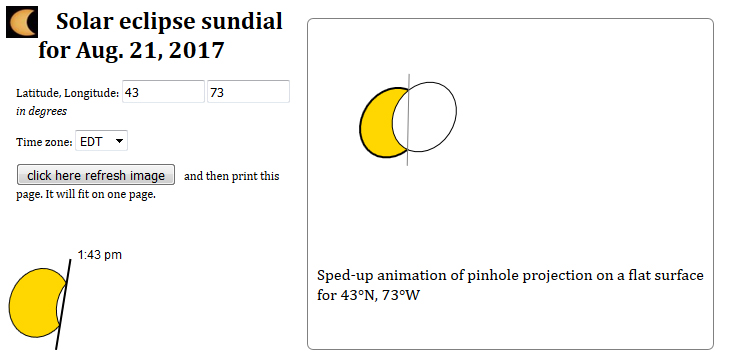 A sundial that only tells time during an eclipse? Back in 2012 Bill Gottesman designed a peculiar dial to tell time by observing the angle between the cusps of the sun during the May 2012 eclipse. Bill Gottesman is back at it with a more sophisticated version assisted by programmer Dan Axtell. This time Bill and Dan give you an animated version of the cusp line, as well as detailed information of the line angle during the eclipse.
A sundial that only tells time during an eclipse? Back in 2012 Bill Gottesman designed a peculiar dial to tell time by observing the angle between the cusps of the sun during the May 2012 eclipse. Bill Gottesman is back at it with a more sophisticated version assisted by programmer Dan Axtell. This time Bill and Dan give you an animated version of the cusp line, as well as detailed information of the line angle during the eclipse.
This is for anywhere in North America that can see the partial or total eclipse. Just enter your latitude and longitude and let the software create you a personal solar eclipse sundial. PLEASE DO NOT OBSERVE THE SUN DIRECTLY WITHOUT AN APPROVED SOLAR FILTER... OR, MAKE A SIMPLE PINHOLE CAMERA FROM A CARDBOARD BOX.
To make your solar eclipse sundial, go to www.eclipsesundial.com
- Details
- Hits: 13756
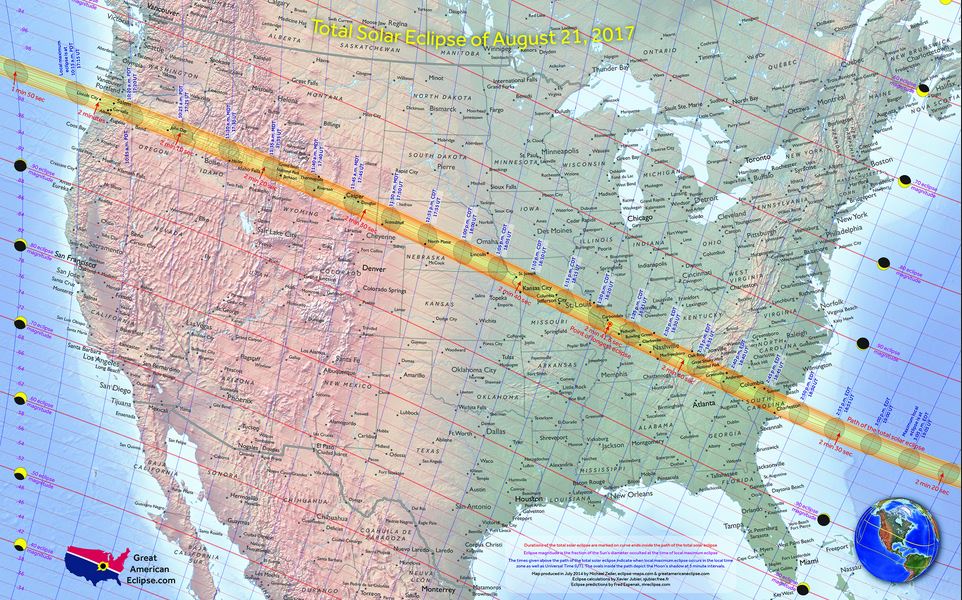 The North American Sundial Society will meet in St. Louis for their annual meeting and to observe the Great American Solar Eclipse on August 21, 2017. Cities and towns across the US are planning events and raising awareness of both the beauty and hazards of the solar eclipse. For the last two years St. Louis groups have delivered more than 100 programs to area schools, libraries, cities, parks and businesses to raise awareness of this historic event which has not happened in St. Louis since the year 1442.
The North American Sundial Society will meet in St. Louis for their annual meeting and to observe the Great American Solar Eclipse on August 21, 2017. Cities and towns across the US are planning events and raising awareness of both the beauty and hazards of the solar eclipse. For the last two years St. Louis groups have delivered more than 100 programs to area schools, libraries, cities, parks and businesses to raise awareness of this historic event which has not happened in St. Louis since the year 1442.
Remember, except for the minute or two of totality, looking directly at the sun will do serious eye damage. Use sun-safe eyeglasses (certified safe for solar viewing) available from many source (see links below or Amazon, etc.). Read about the Great American Eclipse coming near you:
St. Louis, IL: http://stlouiseclipse2017.org/
Other Cities: http://www.eclipse2017.org/2017/in_the_path.htm
- Details
- Hits: 14157
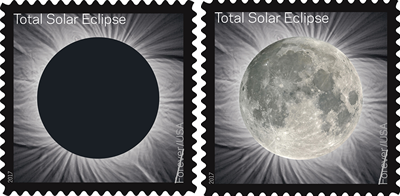 The 2017 August 21st solar eclipse will be commemorated by the US Postal Service with a unique thermochromic ink Forever Stamps: the stamp shows the total Eclipse of the Sun with its corona blocked by a black disk of the moon. However, using the body heat of your thumb or fingers the eclipse image will reveal an underlying image of the moon. The image reverts back to the eclipse once it cools. Fred Espenak, "Mr. Eclipse" a retired NASA astrophysicist, took the photograph of both the eclipse (from Jalu, Libya on March 29, 2006) and the full moon.
The 2017 August 21st solar eclipse will be commemorated by the US Postal Service with a unique thermochromic ink Forever Stamps: the stamp shows the total Eclipse of the Sun with its corona blocked by a black disk of the moon. However, using the body heat of your thumb or fingers the eclipse image will reveal an underlying image of the moon. The image reverts back to the eclipse once it cools. Fred Espenak, "Mr. Eclipse" a retired NASA astrophysicist, took the photograph of both the eclipse (from Jalu, Libya on March 29, 2006) and the full moon.
The USPS states that June 20, 1:30 p.m. MT will be theFirst-Day-of-Issue ceremony, taking place at the Art Museum of the University of Wyoming (UW) in Laramie. The University is celebrating the summer solstice on June 20. Prior to the stamp issuance, visitors are encouraged to arrive at UW's Art Museum's Rotunda at 11:30 a.m. to witness a unique architectural feature at noon when a single beam of sunlight shines from down on a silver dollar embedded in the floor, marking noon on the summer solstice,
The Total Eclipse of the Sun Forever Stamps may be pre-ordered at usps.com/shop in early June for delivery following the June 20 nationwide issuance. The back of the stamp pane provides a map of the eclipse path and times it appears at cities across the US.
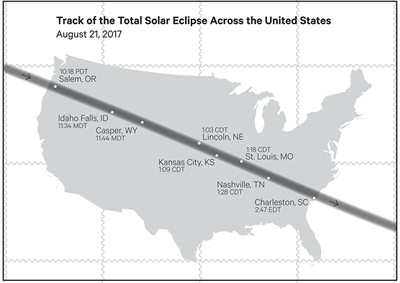
Read more at: NASA Eclipse and for observing tips http://www.mreclipse.com/SEphoto/SEphoto.html
- Details
- Hits: 13479
At the Grolier Club on the Upper East Side of Manhattan is a massive exhibit On Time: The Quest for Precision curated by Bruce Bradley. The exhibit presents the progress of timekeeping over six centuries through 86 rare books from the Linda Hall Library of Science, Engineering & Technology.
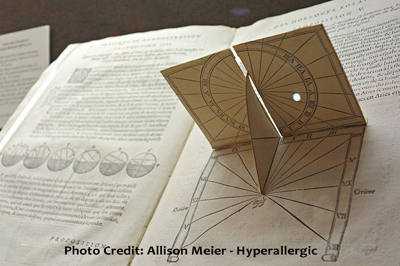
1624 La pratique et demonstration des horloges solaires
|
Journalist Allison Meier of Hyperallergic.com describes a number of books on display such as "German cartographer Sebastian Münster’s 1533 Horologiographia, the first book devoted to sundials, with woodcuts attributed to Hans Holbein the Younger." As shown in her photo, "French engineer Salomon de Caus’s 1624 La pratique et demonstration des horloges solaires has embedded pop-ups to make the workings of its sundials easier to replicate."
The scope of "On Time" stretches from sundials, to water clocks, mechanical clocks and even a Pilkington & Gibbs Heliochronometer, ending with our latest atomic clocks. The display flirts with the possible. While Benjamin Franklin may have suggested using hourly time-telling canon in the 18th century, Athanasius Kircher proposed a fanciful firing sundial a century earlier in his 1646 Ars magna lucis et umbrae in decem libros digesta. His bowl-shaped sundial holds gunpowder at the hours that is ignited by the rays of the sun from a lens. In turn the firing gunpowder triggers hammers to toll hourly bells. If one thinks about this for a moment, Kircher's proposal is as unrealistic as Franklin's. The change in solar declination creates problems for proper placement of the gunpowder, let alone directing the ignition to trigger hammers.
Allison observes that "These manuscripts affirm the centuries of shared ideas that give our modern timekeeping devices their precision." On Time: The Quest for Precision" continues through November 19, 2016.
Read more at: http://hyperallergic.com/327958/on-time-grolier-club-manhattan/
Page 1 of 2

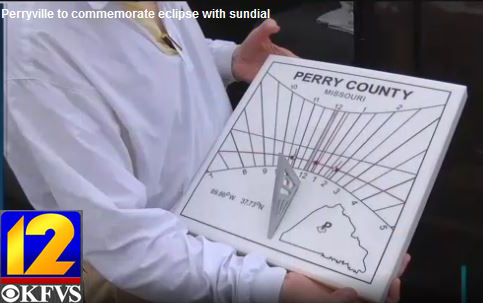 Perryville Eclipse Sundial
Perryville Eclipse Sundial